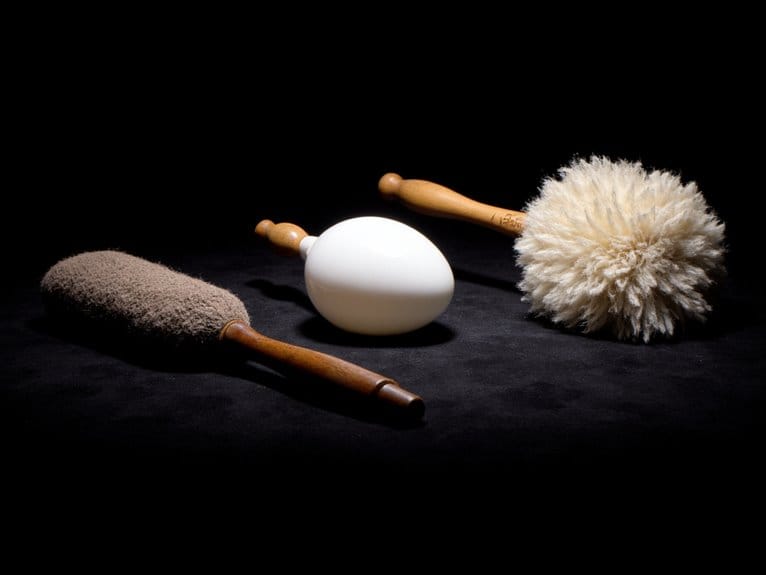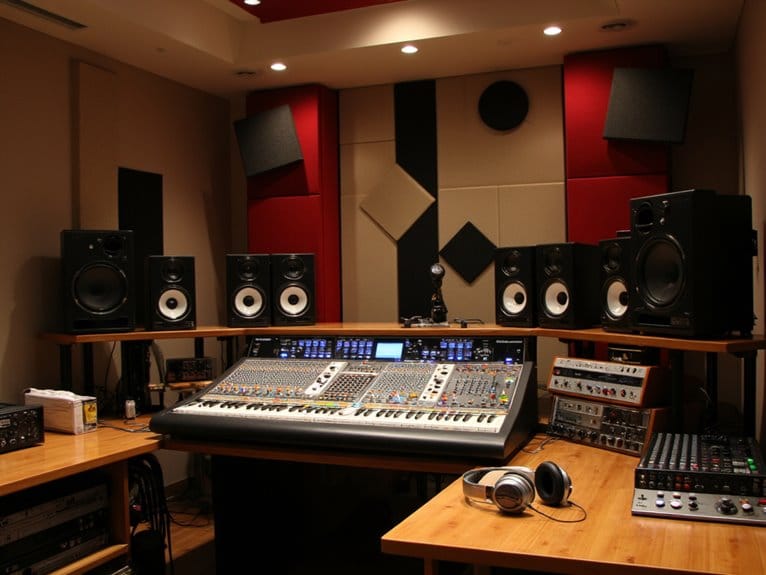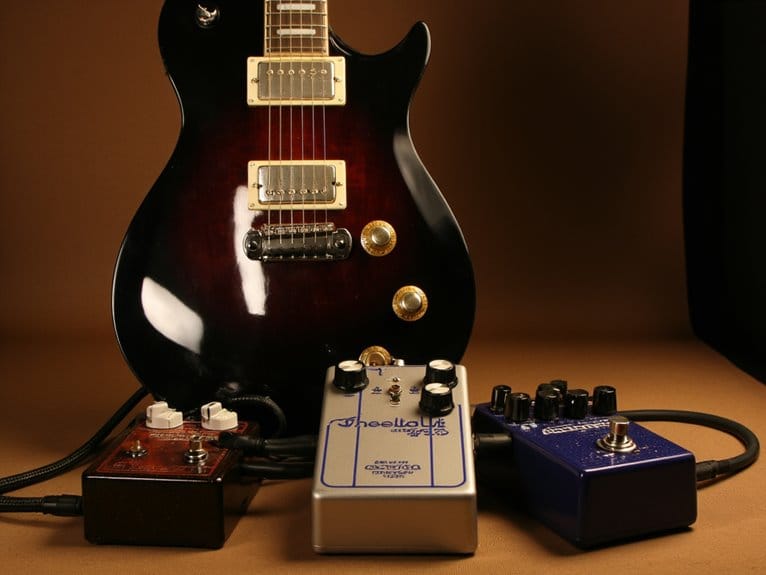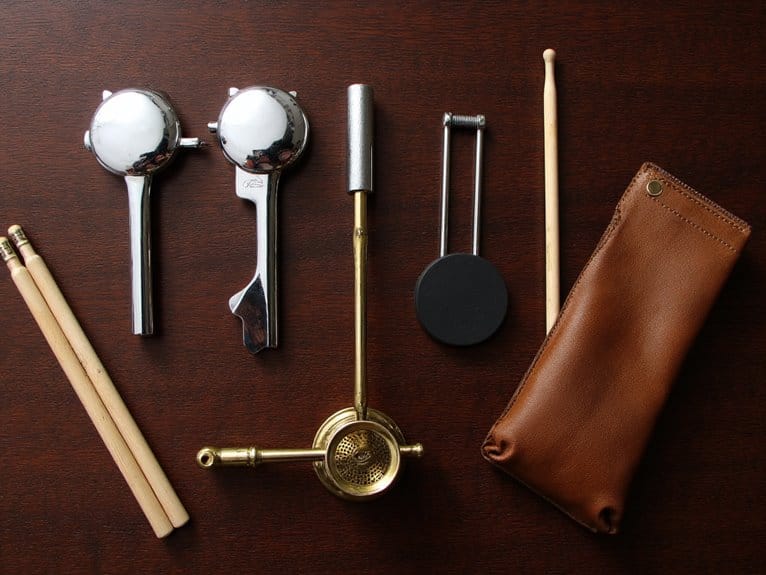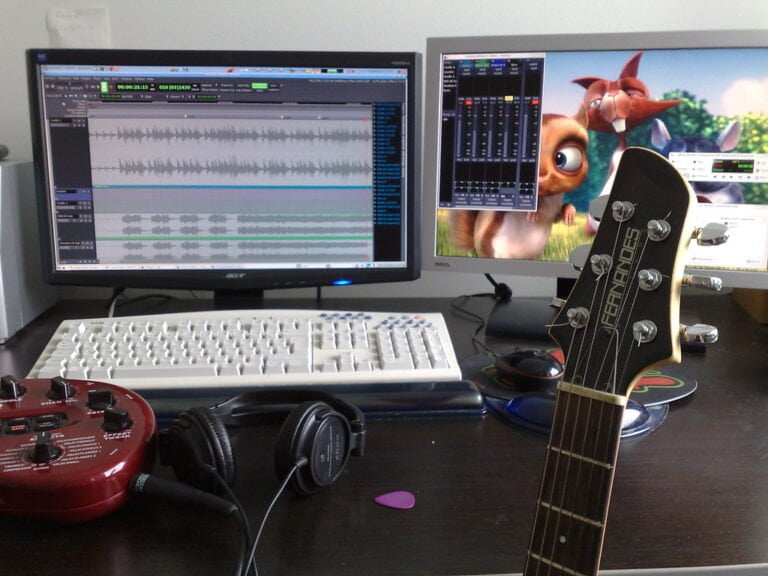Bass Drum Beaters: Felt, Plastic, and Specialty Options
You’ll find that felt beaters offer the most versatility, delivering warm thump with moderate attack that’s perfect for rock, pop, and R&B, while their sound evolves beautifully as the felt softens over time. Plastic and hard material options provide sharp, focused attacks with minimal overtones, making them ideal for aggressive genres that demand cutting clarity and lightning-fast pedal response. Specialty materials like wood bring vintage warmth for jazz applications, while wool and fleece create plush attacks suited for acoustic settings, and understanding these distinctions will transform your approach to drum sound crafting.
We are supported by our audience. When you purchase through links on our site, we may earn an affiliate commission, at no extra cost for you. Learn more.
Notable Insights
- Felt beaters provide warm, rounded tone with moderate attack, ideal for rock, pop, and R&B genres.
- Plastic beaters deliver sharp attack and focused clarity, perfect for aggressive music styles requiring cutting presence.
- Wooden beaters offer vintage warmth suited for jazz, while wool provides plush attacks for acoustic settings.
- Hybrid beaters allow quick material switching between felt and plastic for versatile tonal options during performance.
- Beater shape affects sound: round heads create softer attacks, flat heads maximize projection with sharper strikes.
Felt Bass Drum Beaters: The Gold Standard for Versatility
When it comes to bass drum beaters that deliver consistent performance across multiple musical styles, felt beaters have earned their reputation as the go-to choice for drummers who value tonal warmth without sacrificing punch.
You’ll find that felt beaters produce that rounded thump with moderate attack that sits perfectly in rock, pop, and R&B mixes, emphasizing midrange frequencies while avoiding the harshness of plastic alternatives.
What’s particularly interesting about felt compression is how it actually improves your sound over time – as the material gradually softens with use, you’ll experience subtle tonal evolution that many drummers consider beneficial rather than problematic.
Higher density options maintain their defined character even when you’re playing harder, while adjustable weights on some models let you fine-tune impact power to match your playing style. The excellent good rebound characteristics of felt make these beaters particularly responsive during rapid-fire passages and complex footwork patterns.
Professional drummers consistently praise how flexible felt designs provide shock absorption that reduces leg fatigue during extended playing sessions, making them invaluable for both studio work and live performances. Models like the Vic Firth VICKICK bass drum beater feature a medium felt core with fleece construction that delivers that warm vintage tone particularly valued in studio settings.
Plastic and Hard Material Beaters: Sharp Attack and Articulation
Why settle for soft when you need sharp, cutting power that slices through dense mixes like a knife through butter?
Plastic and hard material beaters deliver the focused attack you’re craving, especially when your drumming demands maximum tonal clarity in aggressive genres like metal and rock. These lightweight champions enable lightning-fast pedal action while maintaining exceptional dynamic range, from whisper-quiet ghost notes to thunderous strikes that’ll wake the neighbors three blocks away.
I’ve found that horizontal angle designs emphasize low-end frequencies through increased contact surface area, while vertical configurations maximize raw power and volume. Hard plastic beaters produce minimal overtones, creating a clean, present sound that cuts through complex arrangements without muddying the mix.
Their enhanced durability means you’ll spend less time replacing worn beaters and more time perfecting those blazing double-kick patterns that define modern heavy music.
Specialty and Hybrid Materials: Unique Tonal Solutions
Beyond the traditional felt, plastic, and hard material trinity lies a fascinating world of specialty beaters that’ll transform your bass drum’s voice in ways you probably never imagined possible.
Wooden beaters, crafted from hardwoods like maple, deliver that warm vintage character essential for jazz and Motown styles, while wool and fleece options provide plush, muffled attacks perfect for intimate acoustic settings.
Hardwood beaters unlock that coveted vintage warmth, while wool options deliver whisper-soft dynamics for delicate acoustic performances.
Hybrid technologies have revolutionized versatility, with dual-surface beaters letting you switch between bright plastic and warm felt without missing a beat.
Material evolution continues with leather-wrapped models like the Low Boy Leather Daddy, composite designs featuring rubber-infused cores, and specialty coatings that reduce drumhead wear while creating unique dynamic responses tailored for specific genres.
When recording your bass drum’s unique character, consider how different beater materials interact with microphone placement and room acoustics to capture the full tonal spectrum you’re creating.
Weight and Shaft Design: Balancing Power and Control
When you’re selecting a bass drum beater, the weight placement along the shaft dramatically affects how much power you’ll generate versus how quickly you can execute rapid passages, making this one of the most critical decisions in your setup.
The shaft material itself, whether it’s standard steel or a lighter alternative, directly impacts your pedal’s responsiveness and the overall feel you’ll experience during performance, particularly when you’re pushing through demanding double bass sections.
Modern adjustable designs let you fine-tune these variables on the fly, allowing you to shift weight distribution and modify shaft length without swapping out the entire beater, which I’ve found invaluable when adapting to different musical contexts throughout a single performance.
The beater angle adjustment works in conjunction with your spring tension settings to optimize both the attack characteristics and rebound response, especially when paired with quality double chain drive systems that provide enhanced power transmission.
Weight Placement Effects
Although most drummers focus primarily on beater head materials and shapes, I’ve found that weight placement along the shaft creates perhaps the most dramatic differences in how your pedal feels and performs during actual playing.
Weight dynamics change remarkably when you position mass closer to the beater head versus near the shaft base, with forward placement delivering stronger impact through increased momentum effects at the striking point.
When weight sits farther back along the shaft, you’ll experience greater rotational inertia, which can slow your response time and require more calf muscle effort during extended playing sessions.
However, this rear positioning also provides smoother acceleration through longer passages, making it ideal for certain musical styles that prioritize consistency over speed.
Shaft Material Impact
While weight placement creates dramatic pedal differences, I’ve discovered that shaft material choices fundamentally alter how your beater transmits power and responds to your playing style.
Steel shafts deliver superior shaft material durability, resisting bending under heavy use while providing increased impact force through higher density construction. Aluminum alternatives offer lighter weight for faster response, though they’re more susceptible to damage during aggressive playing sessions.
Shaft stiffness effects become apparent when you’re executing rapid passages, as flexible shafts reduce power transfer efficiency while stiffer constructions maintain consistent energy delivery.
Here’s what I’ve learned about material selection:
- Steel shafts excel in power-driven genres requiring maximum impact force
- Aluminum shafts enhance speed and responsiveness for technical playing styles
- Diameter increases compensate for material softness, maintaining ideal rigidity
When combining beaters with electronic triggers, dual-zone triggering capabilities allow for more sophisticated sound layering and dynamic response across different areas of the drum head.
Adjustable Design Benefits
Beyond the fixed characteristics of shaft materials, I’ve found that adjustable beater designs represent the most significant advancement in bass drum pedal technology, allowing you to fine-tune every aspect of your beater’s performance without purchasing multiple specialized models.
Weight adjustment techniques let you add or remove mass from the beater head, balancing power with control based on your playing demands. Heavier configurations deliver stronger impact but can slow your footwork, while lighter setups enable faster passages with reduced punch.
Beater angle refinement, typically around 45 degrees, maximizes mechanical efficiency and reduces fatigue during extended sessions.
Adjustable shaft length and distance settings accommodate different drum sizes and playing styles, ensuring ideal rebound characteristics without burying the beater in your drumhead.
Beater Head Shape and Size: Impact on Sound Character
When selecting a bass drum beater, the head’s shape and size function as the primary determinants of your drum’s sonic character, directly influencing everything from attack sharpness to overall volume output.
Understanding beater shape effects reveals how round heads produce softer attacks with less surface contact, while flat-faced designs maximize projection through increased head contact.
Beater size implications become evident when you consider that larger heads transfer more energy for greater volume and fuller bass response, whereas smaller diameters create focused, higher-pitched strikes.
Key shape and size considerations include:
- Round heads – Softer attack, warmer tone, reduced volume
- Flat heads – Sharp attack, maximum projection, brighter sound
- Large diameter – Increased volume, fuller bass response, rounded tone
Material density combined with these physical characteristics determines your final sound balance. Heavy hitters often require different beater specifications to accommodate their playing style and achieve proper tonal response characteristics.
The beater’s impact characteristics directly affect how microphones with cardioid pickup patterns capture and isolate the drum’s frequencies during recording sessions.
Choosing the Right Beater for Your Musical Style
Your musical style serves as the primary compass for selecting the ideal bass drum beater, since each genre demands specific tonal characteristics that directly influence your overall sound within the mix.
Jazz drummers typically gravitate toward yarn or soft flannel-wrapped beaters for their warm, controlled response, while metal players often choose wooden or metal beaters to achieve the aggressive, articulate attack that cuts through heavily distorted guitars.
Rock and pop styles generally benefit from medium-density felt beaters, which provide the balanced attack and sustain necessary for handling the dynamic shifts common in these genres.
Genre-Specific Beater Selection
While I’ve spent countless hours experimenting with different beater combinations across various musical contexts, I’ve learned that selecting the right bass drum beater for your specific genre isn’t just about personal preference—it’s about understanding how different materials, weights, and designs fundamentally shape your drum’s voice within the musical landscape you’re creating.
Through my genre exploration and beater experimentation, I’ve discovered three fundamental categories:
- Rock/Metal: Wood or metal beaters deliver the aggressive attack and punch needed for cutting through distorted guitars and dense mixes.
- Jazz/Blues: Felt beaters provide warmth and dynamic control essential for subtle ghost notes and syncopated rhythms.
- Pop/Funk: Medium felt or dual-material beaters balance articulation with groove-friendly warmth.
Each genre demands specific tonal characteristics that proper beater selection readily provides. Just as dynamic microphones excel in high sound pressure live environments, your beater choice becomes crucial for achieving the optimal sound in your genre’s typical performance settings.
Similar to how jazz musicians prioritize controlled wash and stick definition when selecting ride cymbals, bass drum beater selection requires understanding how material density affects both attack clarity and sustain characteristics within your chosen musical style. For jazz specifically, many drummers prefer smaller bass drums like 18 or 20 inches because they offer better punch and control without overwhelming smaller venues.
Sound Characteristics Matching
Beyond understanding which beaters suit different genres, matching sound characteristics to your specific musical style requires analyzing how beater materials, shapes, and weights interact with your drum setup to create the exact tonal signature your music demands.
I’ve found that successful beater interaction starts with identifying whether you need warm sustain, sharp attack, or balanced presence in your mix. Felt beaters paired with coated heads emphasize low-end warmth, while plastic beaters on clear heads deliver cutting brightness that penetrates dense arrangements.
Through systematic tonal experimentation, you’ll discover how weight affects your pedal’s responsiveness and how beater shapes alter impact zones on your drumhead, ultimately allowing you to fine-tune attack characteristics and sustain properties that complement your musical vision perfectly.
Frequently Asked Questions
How Often Should I Replace My Bass Drum Beaters?
You should replace bass drum beaters based on visible wear rather than fixed schedules. Beater lifespan varies with playing style and frequency. Regular maintenance tips include inspecting for cracks, flattening, or sound quality changes.
Can I Use Different Beaters on Double Bass Drum Pedals?
You can absolutely use different beaters on double bass drum pedals since most offer excellent beater compatibility. Different materials will affect your pedal performance, so you’ll need to adjust height and angle settings for best feel.
What’s the Price Range for Quality Bass Drum Beaters?
When doing price comparison for bass drum beaters, you’ll find budget options starting around $16, mid-range quality beaters from $26-60, and high-end specialty models exceeding $80 for professional performance.
On a final note
You’ll find that selecting the right bass drum beater isn’t just about personal preference, it’s about matching your musical demands with the specific tonal characteristics each material and design offers. Whether you’re gravitating toward felt’s warmth, plastic’s punch, or specialty hybrids’ unique voices, remember that your beater choice directly impacts your sound’s clarity, power, and musical expression. Don’t be afraid to experiment with different combinations.

